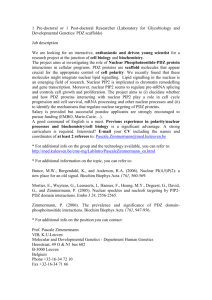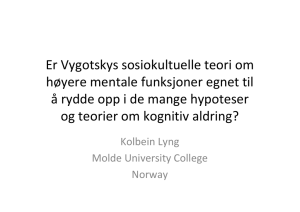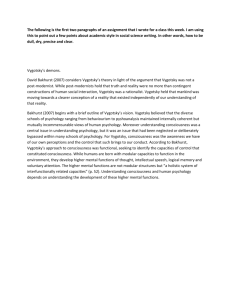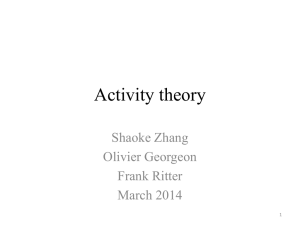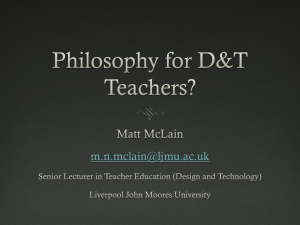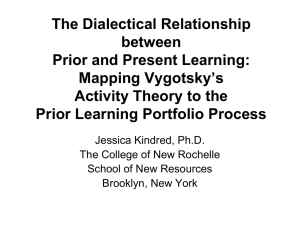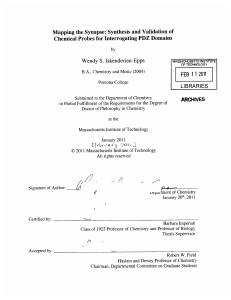3 Description of the Proposed Environment
advertisement
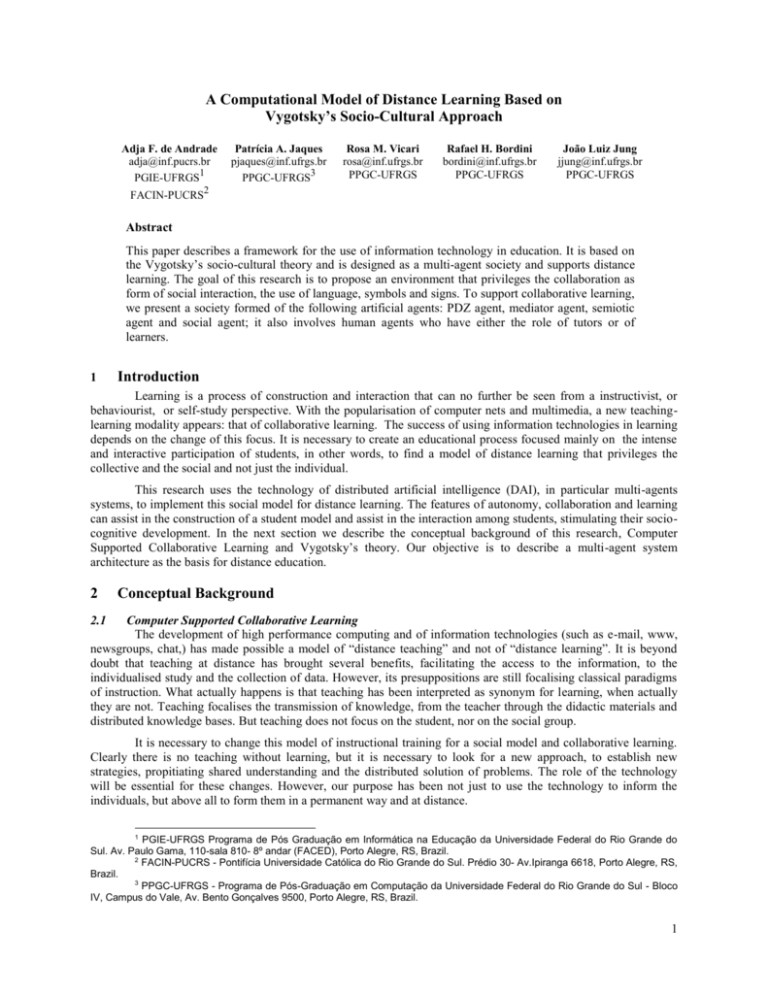
A Computational Model of Distance Learning Based on Vygotsky’s Socio-Cultural Approach Adja F. de Andrade adja@inf.pucrs.br 1 PGIE-UFRGS FACIN-PUCRS Patrícia A. Jaques pjaques@inf.ufrgs.br 3 PPGC-UFRGS Rosa M. Vicari rosa@inf.ufrgs.br PPGC-UFRGS Rafael H. Bordini bordini@inf.ufrgs.br PPGC-UFRGS João Luiz Jung jjung@inf.ufrgs.br PPGC-UFRGS 2 Abstract This paper describes a framework for the use of information technology in education. It is based on the Vygotsky’s socio-cultural theory and is designed as a multi-agent society and supports distance learning. The goal of this research is to propose an environment that privileges the collaboration as form of social interaction, the use of language, symbols and signs. To support collaborative learning, we present a society formed of the following artificial agents: PDZ agent, mediator agent, semiotic agent and social agent; it also involves human agents who have either the role of tutors or of learners. 1 Introduction Learning is a process of construction and interaction that can no further be seen from a instructivist, or behaviourist, or self-study perspective. With the popularisation of computer nets and multimedia, a new teachinglearning modality appears: that of collaborative learning. The success of using information technologies in learning depends on the change of this focus. It is necessary to create an educational process focused mainly on the intense and interactive participation of students, in other words, to find a model of distance learning that privileges the collective and the social and not just the individual. This research uses the technology of distributed artificial intelligence (DAI), in particular multi-agents systems, to implement this social model for distance learning. The features of autonomy, collaboration and learning can assist in the construction of a student model and assist in the interaction among students, stimulating their sociocognitive development. In the next section we describe the conceptual background of this research, Computer Supported Collaborative Learning and Vygotsky’s theory. Our objective is to describe a multi-agent system architecture as the basis for distance education. 2 Conceptual Background 2.1 Computer Supported Collaborative Learning The development of high performance computing and of information technologies (such as e-mail, www, newsgroups, chat,) has made possible a model of “distance teaching” and not of “distance learning”. It is beyond doubt that teaching at distance has brought several benefits, facilitating the access to the information, to the individualised study and the collection of data. However, its presuppositions are still focalising classical paradigms of instruction. What actually happens is that teaching has been interpreted as synonym for learning, when actually they are not. Teaching focalises the transmission of knowledge, from the teacher through the didactic materials and distributed knowledge bases. But teaching does not focus on the student, nor on the social group. It is necessary to change this model of instructional training for a social model and collaborative learning. Clearly there is no teaching without learning, but it is necessary to look for a new approach, to establish new strategies, propitiating shared understanding and the distributed solution of problems. The role of the technology will be essential for these changes. However, our purpose has been not just to use the technology to inform the individuals, but above all to form them in a permanent way and at distance. 1 PGIE-UFRGS Programa de Pós Graduação em Informática na Educação da Universidade Federal do Rio Grande do Sul. Av. Paulo Gama, 110-sala 810- 8º andar (FACED), Porto Alegre, RS, Brazil. 2 FACIN-PUCRS - Pontifícia Universidade Católica do Rio Grande do Sul. Prédio 30- Av.Ipiranga 6618, Porto Alegre, RS, Brazil. 3 PPGC-UFRGS - Programa de Pós-Graduação em Computação da Universidade Federal do Rio Grande do Sul - Bloco IV, Campus do Vale, Av. Bento Gonçalves 9500, Porto Alegre, RS, Brazil. 1 In this sense, the technologies of distributed artificial intelligence (in particular multi-agents system), virtual reality, multimedia systems and the Web can constitute excellent allies in the construction of a learning model that favours social interaction among individuals, propitiating the formation of groups or virtual communities of learners. In terms of research in collaborative learning, Pierre Dillenbourg (Dillenbourg, 1994) analyses various conceptions of learning that can give foundation for a computational model: the constructivist approach, which focalises the individual in the context of social interaction, the socio-cultural approach, which focalises the relationship between the individuals, and the shared cognition approach, which focalises the environment (which includes a physical context as well as a social one). Among these conceptions and looking for a computational model of social learning, this paper proposes an approach of multi-agent systems based on the socio-cultural perspective proposed by Vygotsky. Vygotsky’s Socio-Cultural Approach To support the collective model of distance education, the purpose of this work has as theoretical foundation, the theory of Vygotsky (1998). One of the important concepts of the theory of Vygotsky is that mental activities are based on social relationships between the individual and the environment in a historical process and that this relationship is mediated by symbolic systems, through instruments and signs. For Vygotsky (1998) the signs are artificial incentives with the purpose of mnemonic aid; they work as middle ground for adaptation, driven by the individual's own control. The signs act as instruments of the psychological activity. They are auxiliary means to solve a given problem and they are guided internally. The function of an instrument is to serve as tool between the worker (in the case of this research, the student) and the object of his work, seeking help in some activity; these are guided externally. Both have in common the mediation function. 2.2 Another fundamental concept in the Vygotsky´s theory is the proximal development zone (PDZ). In mentioning the PDZ, it is necessary to define which are the levels of the student's development: the Real Development Level (RDL) refers to the functions that the student already possesses. The Potential Development Level (PDL) determines the functions that a pupil can develop, through an adult's aid or from the collaboration of more experienced friends. PDZ is "the distance between the real level of development, determined by the capacity to solve a problem independently, and the level of potential development, determined by the resolution of a problem under an adult's orientation or in collaboration with other more capable students". Besides these concepts Vygotsky defends that cognitive functions happen first at social level for later to happen at an individual level: firstly among people (inter-psychological) and, later, within the person (intra-psychological). The psychological abilities, in the same way, happen initially in social relationships (inter-mental) and afterwards within the child (intra-mental). 3 Description of the Proposed Environment The Environment’s Pedagogical Model The pedagogical model in this research is based on searching for a collaborative form of learning that is accomplished through social interaction. The interactions can be of various types, considering criteria as temporality, the number of participants, the amount of reciprocity, the hierarchies, and even perceptual criteria based on behaviour traits, personality, motivations and emotional state of the individuals. Regarding the temporality criteria, the interactions can be synchronous or asynchronous. Regarding the number of participants, the interaction can be “one-to-one”; or “one-to-all” and “all-to-all”. Concerning the reciprocity criteria, an interaction can be reciprocal or not reciprocal. In terms of hierarchical interactions, a previous analysis of the participants is made classifying them in upper, inferior and moderate. Moreover, social interactions can be motivated by some perceptual factors, interpersonal attitudes and relation of roles, considering aspects such as age and personality traits. The identified perceptual factors are the effort, the confidence and the independence that influence directly in the motivation, as suggested by (Bercht et al., 1999). 3.1 2 3.2 Computational model of the Environment The proposed system has four types of artificial agents – the PDZ agent, the mediating agent, the social agent and the semiotic agent – as well as human agents (students and tutors). The artificial agents monitor and assist the human agents in their collaborative activities. In the proposed system, all the individuals, students and tutors, are described as integrated social agents in an environment of collaborative learning. The system we have proposed is being developed using JAVA and KQML for message exchange among agents. Figure 1 illustrates the architecture of the proposed system. Groups profile Social Agent Group Models Semiotic Agent Student preferencie Individual profile Pedagogical content WWW Exercises Examples Login information Pedagogical content Pedagogical estrategies PDZ Agent Student behavior Student Model Mediating Agent ... PDZ Agent Mediating Agent Student Model Agent that represents the student Agent that represents the student Interface preferencies Student Student Figure 1: A Society of Social Agents for Learning Environments We can observe in the figure that each instance of the PDZ and mediating agents are responsible for monitoring and interacting with one particular student. The semiotic and the social agents perform activities related to the whole society. Although PDZ and mediating agents interact between themselves, only PDZ agents interact with the social agent in the search for partners to assist a certain student in his/her learning process. The mediating agents interacts with the semiotic agent to obtain the symbols that should be presented to the students. The mediating agent can access the student’s model to check whether it is necessary to present new symbols, but only the PDZ agent can update the student’s model. 3.3 PDZ Agent The system has PDZ agents that are responsible for observing the real development of the students and propose activities which would make their real capacities (Real Development Level) as close as possible to the desired ones (Potential Development Level). As each of these agents monitors only one student, there is one PDZ agent for each student. The PDZ agent, based on the theory of Vygotsky (1998), is responsible for stimulating those 3 functions of the student that have still not matured, but are in a development process. A PDZ agent can have functions such as: to vary the degree of control of the joint activities, to consider tasks gradually, or to modify the offered forms of help/support. In order to assist in the learning process, a PDZ agent must have a student model, identifying his/her abilities and deficiencies, which will be constructed by the observation of the user’s interactions. In this way, it is capable to indicate to what extent the student’s cognitive abilities can expand; it does so by having access and modifying that model. The student model contains the following information: type of personality – referring to the works of (Castelfranchi et al., 1997; D'Amico et al.; 1997), self-confidence, initiative, participation and beliefs of the student. It is important to stress that the beliefs of the students are deduced from the interactions and that, in a collaborative group, individual beliefs of the students can also include beliefs about the other members of the group. For that purpose, certain formalisms, such as the X-BDI model (Mora, 1998), that allow for the representation of beliefs and that are capable of making inferences (and also to represent information about the students such as personality traits) are useful. 3.4 Mediating agent The mediating agent is responsible for the interface between the system and the student. The central difference between the mediating agent and PDZ agent is that the first one carries through all the tasks of interface and communication with the user, as also implements the interactions between the users. The PDZ agent, in turn, is responsible for the learning process (that is, the construction of the student’s model), and for the identification of deficiencies in learning through the observation of the actions of the user. Besides the function of mediating the interaction of the student with the PDZ agent, the mediating agent must have access to the student’s model, helping the prediction of the behaviour of that student which allows to determine the best actions to be executed to assist the learning process of the student. 3.5 Semiotic agent For the mediating agent to fulfil its role, it is necessary the intervention of external stimulation (like instruments and signs) to the student. The semiotic agent assists the cognitive activity of the student by introducing these elements, for example in order to help the student solving a problem. For that purpose, the agent will use such signs as pictures, texts and numbers. 3.6 Social agent The social agent knows all PDZ agents of the society, and these also have knowledge of the presence of the social agent. Its function is to establish the integration of the society and to construct models of student groups. One of the activities of the social agent is to investigate the existence of students who have the necessary knowledge, beliefs and types of personality which would propitiate the best cooperation between students. In collaborative learning, the group is an active entity; therefore, the system must contain information that refers to it as a whole. This information generates a group model which is constructed and stored by the social agent. A group model can be constructed from the individual students’ models obtained from the interactions of the students with their PDZ agents, and also from the observation of the groups by the social agent. A group model is composed of the following information: agreement, affection, group beliefs, self-confidence and conflict. 3.7 Human agent The human agents are seen as agents that establish social relationships to each other according to its personal characteristics and personality. Thus, it is important that traits and characteristics of the student's personality are contained in the model (Castelfranchi et al., 1997), since those traits will affect the interaction directly through the roles that each student will play. These roles determine affection relationships that will happen in a group of students, causing those students to always form the same work group based on similarities (for example, knowledge and beliefs) and common difficulties. The knowledge of the personality is necessary to understand the actions accomplished by the agents and the relationships among the agents during the interaction. 4 The Interaction among Agents The interaction among agents is not restricted to the proposed computational model. On the contrary, the computational interaction among the artificial agents aims to contribute even more for the communication and the exchange among the human agents. The interaction will be one of the main objectives of this model, because the 4 proposal is about a model of collaborative learning. The several interaction forms involved in the model are: interaction among artificial agents; interaction among artificial and human agents, and interaction among human agents. In respect to communication among the human agents, the system offers tools (synchronous or asynchronous) when the physical presence is not possible (for example, in the case of virtual classes). It is important to emphasise that, in this case, the agents in this system do not accomplish any task of mediation of the interaction among the users of the environment (through negotiation, argumentation or resolution of conflicts). For an account of cognitive conflicts that happen in a group model, refer to (Tedesco, 1998). Initially, the PDZ agent is directly related with the social agent and with the fact that the interaction with this agent can favour the student's intellectual development from the interaction with the environment. When it is observed that the student is not reaching the expected level of learning, the system works as an Intelligent Tutoring System (ITS). The PDZ agent, in this case, will notify to the mediator agent which will then make relevant requests to the semiotic agent. The semiotic agent should choose, from the knowledge base, the sign which is best suited to that determined situation and to deliver it to the mediating agent, which should then exhibit it to the user. Therefore, the mediating agent will be situated within of the scheme “incentive - mediation link – answer”. 5 Conclusions and Future Work In this work, was proposed a computational model of a learning society from a multi-agent system perspective. It is composed of four types of artificial agents: the PDZ agents, the mediating agents, the semiotic agent and the social agent; it also includes two types of human agents (students and tutors). The inclusion of such agents in a distance learning environment enables an inter-personal process to become intra-personal, conceiving learning as a process of social interaction. The proposed model aims to conceive the teaching-learning process as a collective process, it prioritises collective learning and social interaction in opposition to the competitive approach, which prioritises the individual. In this type of learning, aspects such as knowledge exchange among the subjects, commitment, negotiation and shared understanding of the problems (besides the mutual help to solve them) should be promoted. Therefore, we propose a group model that contains important information on the groups, which are seen as integrating a society that aims at improved social interaction among its pairs. As proposal of future work, we intend to improve the representation of human characteristics (emotions, beliefs and personality traits) within the artificial agents, turning the agents more “believable”. These would guarantee a larger degree of realism and motivation to the teaching-learning environment (Canamero and Velde, 1997; Castelfranchi et al., 1997). 6 References (Bercht et al., 1999) Bercht, M.; Moissa, H.E.M; Viccari, R.M. Identificação de fatores motivacionais e afetivos em um ambiente de ensino e aprendizagem. SBIE’99 – Simpósio Brasileiro de Informática na Educação. November 23-25, 1999, Curitiba, PR (Poster). (Canamero and Velde, 1997) Canamero, Dolores and Velde, Walter Van de. Socially Emotional: Using Emotions to Ground Social Interaction. Socially Intelligent Agents. In: AAAI FALL SYMPOSIUM, 1997, Cambridge. Menlo Park: AAAI Press, 1997. (Castelfranchi et al., 1997) Cristiano Castelfranchi, Fiorella de Rosis e Rino Falcone. Social Attitudes and Personalities in Agents. Anais Socially Intelligent Agents. In: AAAI FALL SYMPOSIUM, 1997, Cambridge. Menlo Park: AAAI Press, 1997. (Dillenbourg, 1994) Dillenbourg, P., Baker, M.,Blaye, A and O´Malley, C. The evolution of research on Collaborative Learning. In Spada, H. and Reimann, P., (eds.), Learning in Humans and Machines. (D’Amico et al.; 1997) D'Amico, C.; Viccari, R. M.; Engel, P. M. Neural Networks Applied to Distributed Teaching and Learning Environments. IV Simpósio Brasileiro de redes neurais. Goiania, 1997 (Mora et al., 1998) Mora, M.C.; Viccari ,R.M; Lopes, J.G.P; Coelho,H. BDI models and systems: reducing the gap . ATAL’98 –Paris, July, 1998. (Tedesco, 1998) Tedesco. P. Mediating Meta-Cognitive Conflicts in a Collaborative Problem-Solving Situation" abstract presented at the II HCT Workshop "Bridging the Gap", Brighton, 2/3 October, 1998 (Vygotsky, 1998) Vygotsky, L. S. A Formação Social da Mente: o Desenvolvimento dos Processos Psicológicos Superiores. Editora Martins Fontes, São Paulo, 1998. (Vygotsky, 1998a) Vygotsky, L. S. Pensamento e Linguagem.- 2 ed.- São Paulo: Martins Fontes, 1998. 5
